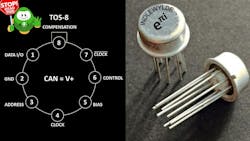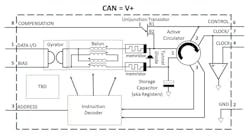New Linear Processor Crushes AI and Other Complex Problems
This article is part of the April 1st series in the Humor section of our Series Library.
What you’ll learn:
- How the eπi processor trivializes NP-hard problems.
- How to incorporate and program the eπi processor.
A novel processor has been introduced by Indlewylde Corporation that’s said to provide phenomenal performance and performance/watt advantages over existing digital CPUs, GPUs, APUs, and XPUs. The processor, dubbed eπi, after “the most beautiful equation in mathematics,” is expected cause a complete about-face in the world of computer architectures—it replaces current clumsy digital mathematics algorithms with linear circuits’ inherent math processing strengths to accelerate all workloads ranging from image processing to AI.
The processor trivializes NP-hard problems, thermodynamics, fluid dynamics, thermonuclear equations, and calculating the number of jellybeans in a jar. Its developers claim that a single dual-sided PCB the size of a paper plate, loaded with 20 of these processors, should outperform most modern supercomputing data centers while consuming less than 3 W of power.
The eπi linear processor works solely in the linear domain. Addresses, data, and even control signals are represented by multiple voltages on a single pin. “Multilevel cell flash touches on this concept in the most reluctant and timid way, while desperately hanging onto digital electronics for its addressing and interface,” said Dr. Egbert Dweeselman, the chip’s lead architect. “But we have taken an aggressive stance by removing even the slightest vestiges of digital electronics in this exciting new processor.”
An example of the superiority of this approach lies in a simple multiplication of two numbers. With digital electronics, multiplies consume hundreds of gates and take dozens of cycles to implement in their most basic form, while linear multiplies can be performed in a microsecond by as little as a single transistor. “This not only slashes cost and complexity,” boasts Dr. Dweeselman, “but it also nearly eliminates energy consumption, while shrinking the die size by four or five orders of magnitude.”
What About the Hardware?
A simple block diagram appears to be self-explanatory (Fig. 1). A single DATA I/O pin accepts or drives linear voltages to the outside world, while the ADDRESS pin issues a voltage indicating the desired memory location. The CONTROL pin expresses whether the command is a Memory Read or Write, or an I/O Read or Write, along with information about the current state of the processor. There are no interrupts, because the chip concentrates better when not incessantly badgered with an annoying series of interruptions.
Though the processor is aimed at a fully linear system, the designers realized that it might take some time for the computing world to transition to such a radical approach. With that in mind, the processor has been designed to interface with standard digital chips like memories. Since there are no digital signals, digital-to-analog and analog-to-digital converters (DACs and ADCs) are used as an interface between the processor and any digital parts of the system.
This also allows designers to choose parameters that would normally be predetermined by a digital CPU, like data precision and the extent of the address space. If you want higher precision, you simply attach higher-resolution DACs and ADCs to the DATA I/O pin. The DAC’s increased resolution also provides access to a larger number of instructions. To extend the address range, designers simply attach a higher-resolution ADC to the ADDRESS pin.
While the current model provides no support for more than two bits of precision on the CONTROL pin, once that pin has shared its two bits, it goes away satisfied.
Packaging and Other Features
The eπi ships in a standard low-pin-count, 8-lead TO-99 package next to the pinout diagram (Fig. 2). The package is somewhat novel in its use of a grid cap, a concept formerly only seen on vacuum tubes. Although not immediately visible in the photo, this function is carried out by the can, which can be wired into the circuit by using a clamp.
Clock frequency can be set by connecting the two CLOCK pins via a capacitor, crystal, delay line, SAW filter, ceramic resonator, cavity resonator, tuning fork, slide whistle, or antenna. For extremely high-performance applications, the designers are working on a version whose DATA I/O and ADDRESS signals are connected via waveguides rather than wires.
Because of the chip’s extraordinarily low power consumption, no heatsink is necessary, although cooling can be helpful to reduce thermal noise. Best results can be achieved by bathing the package in liquid helium. It’s a practice that trades off precision against safety, since engineers are known for clumsiness, possibly spilling liquid helium on themselves with disastrous results. Indlewylde Corporation has already had to send two researchers to the Emergency Room, after which the company’s cryogenic cooling experiments were curtailed.
A One-of-a-Kind Instruction Set
The instruction set for the eπi is unique, to say the least. It takes full advantage of linear electronics’ strengths to perform math that typically brings other processors to a standstill. For example, the digital fast Fourier transform technique was developed to overcome the computationally intensive and slow process of calculating a standard Fourier transform on digital computers.
On the eπi, a Fourier transform is performed on-the-fly without any need for an elaborate optimization. Outputs are supplied in real-time. This has a lot to do with the device’s internal use of complex numbers. The same is true of the other transform types supported by the eπi as single instructions, including Cosine, Laplace, and Hadamard transforms. Inverses of all of these transforms simply involve negating the voltage assigned to any transform’s instruction.
Vector math, matrices, and linear algebra are supported in complex numbers, all with single-instruction operators. As with the transforms, matrix inversions can be performed by negating the instruction voltage for any of the matrix operators. This wealth of matrix functions not only provides superb support for AI, but lends itself to efficient programming in APL rather than currently popular digitally oriented languages like C++.
To address today’s shortage of experienced APL programmers, Indlewylde has recorded an APL tutorial in 371 twenty-minute Portuguese-language episodes. These are scheduled to be released on YouTube by the first of April next year, with English translations the following April 1.
There are several built-in commonplace functions, including Hyperbolic Trig Functions (Sinh, Cosh, Tanh, Cotanh, ArcSinh, ArcCosh, ArcTanh, and ArcCotanh, all based on gradians, rather than radians or degrees), Autocorrelation and Cross Correlation, Differentials and Integrals (both full and partial) over time or against another variable, Surface Integrals and Differentials in n-space, rich Polynomial Solutions, and many less-common functions.
Built-in constants include e, 1/0, i, Boltzmann’s constant, Avogadro’s number, and others. An internal noise diode supplies random numbers. Natural logarithms and powers of e are also built in. Addition, subtraction, multiplication, and division aren’t supported.
“Oddly, math performed on irrational numbers seems to run faster than that done on rational numbers, but we don’t know why,” admitted Dweeselman.
Price and Availability
Indlewylde tells us that the eπi is now available in sample quantities from all of the usual sources. Pricing for volume orders follows a Dutch Auction approach—lower prices for low volumes, with prices increasing at higher volumes. Special pricing will be considered in exchange for a modest side payment to sales management.
Full documentation and software support is currently under development.
Read more articles in the April 1st series in the Humor section of our Series Library.






